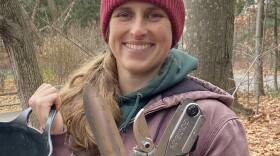Instead of cutting down a tree, or unpacking a plastic one from a box, consider enjoying a living Christmas tree inside your home during the holidays, which you can later plant outside.
Homegrown NH’s Emma Erler, lead horticulturist at Kirkwood Gardens at Squam Lakes Natural Science Center, says the investment of time and effort is a way to keep Christmas memories alive year after year, without the guilt of cutting down a tree that gets thrown away a few weeks later.
Choosing the right tree
Many evergreen species are good landscape trees in New Hampshire, such as Serbian spruce, Norway spruce, white spruce, Fraser fir, balsam fir and white fir. Garden centers and nurseries often carry these plants during the holiday season.
Success with a living tree starts with choosing the right one. Live trees can be purchased in one of two ways – container-grown or balled and burlapped.
Larger trees will typically be balled and burlapped, but it is also possible to find smaller containerized plants, which are a little easier to maneuver inside of the home. If you do buy a balled and burlapped plant, leave its wrappings in place inside the home.
Keeping it alive
Try to purchase the tree a week or two before you plan to bring it inside, and stage it in an unheated space such as a shed, garage or porch to help the tree make the transition between outdoor cold and the inside of your home.
While this step isn’t absolutely necessary, it can put less stress on the tree. Keep the roots moist during this time..
Setting up the tree inside
Live trees should only be kept indoors for 7 to 10 days. Any longer and the tree may start to lose its winter dormancy due to exposure to warmth, making it impossible to put the tree back outside after the holidays without causing injury.
Once inside the home, live trees should be grown like any other houseplant. Ideally, the tree should be placed in a cooler area away from heat sources, such as vents, woodstoves or fireplaces. LED or low temperature lights should be used for decorating.
Water regularly, allowing the soil to dry out between waterings.
To avoid making a mess, place the tree inside of a large leak-proof pot or tub that will collect excess water. Place a few stones or a board beneath the root ball of the tree to keep it from sitting in standing water – a situation that can be deadly for evergreens.
What to do after the holidays
Move your tree to an unheated structure for the rest of the winter and check to see if it needs water periodically. If you don’t have a cool garage or shed, place the tree in a protected spot out of prevailing winter winds and mulch the root system.
Don’t plan to plant your Christmas tree immediately after the holidays. Even if it is possible to dig a hole for it, the tree is unlikely to survive if planted so late in the season.
No room for a large tree?
If you don’t have room for a full-sized live Christmas tree, consider a living tabletop tree.

Dwarf Alberta spruce (Picea glauca) is a hardy shrub that is popular in formal landscapes. It naturally grows upright in a conical shape and is perfect as a miniature Christmas tree. Like other full-size trees, it should only be kept indoors for a short amount of time, and planted in the spring.
A few indoor plants can also be good alternatives, such as Norfolk Island pine (Araucaria heterphylla). Norfolk Island pine is a tropical evergreen that is fairly easy to grow indoors. When placed in a spot with bright, indirect light from an eastern or western window and given consistent soil moisture, plants can live for many years. The main downside is that the branches are too weak to support most ornaments.
Other indoor possibilities include lemon cypress (Cupressus macrocarpa) and rosemary, both of which can be brought outside in the summer.
If you have a question for Homegrown NH, send us an email or voice memo to Homegrown NH@NHPR.org.
See you in the garden!
Homegrown New Hampshire is a collaboration between Squam Lakes Natural Science Center and NHPR.










